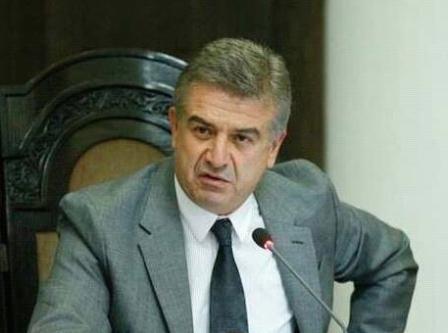


ArmInfo. Indicators of collecting personal incomes of communities and amounts in garbage collection are unsatisfactory, there are shortcomings in planning and gathering, Prime Minister of Armenia Karen Karapetyan stated during a meeting held on August 4 in Armavir region of Armenia.
According to the press service of the RA executive body, the meeting discussed the implementation of the development programs for the region and communities, ongoing work and forthcoming tasks.
Presenting the socio-economic situation and the main indicators of the region, the governor of the Armavir region Ashot Ghahramanyan noted that in the GDP indicator of the republic in 2015-2016. The share of the region was 5-6%. The volume of gross agricultural production is 167 billion AMD. 48002 villagers and farming enterprises are engaged in agriculture, 34 organizations are processing and manufacturing agricultural products. 11 of the investment programs presented to the Government from the Armavir region refer to the sphere of agriculture.
According to him, with the support of the Prime Minister of the Republic of Armenia in the Lernamerdz community, solar stations have been installed, work is under way to search for donors for the installation of solar stations in another 9 non-gasified communities in the region. Five-year programs for the development of 97 communities of the region have been developed, and work has been carried out to compile and execute budgets.
As of August 1, 2017, with the planned 1.3 billion AMD, the actual collection of the communities' own revenues amounted to 1.1 billion (84.9%). Ashot Ghahramanyan noted that after the prime minister's instruction, special attention was paid to justifying the expenses for maintenance of municipal enterprises under the budgets of the communities. Currently, the cost of food, staff, the number of pupils and the implementation of budgets in preschool educational institutions of the region are analyzed. Within the framework of the "Clean Armenia" program, 171 dumps were recorded in the communities of the region, 130 of which were to be cleared, the rest being active dumps. During the national cleaning days held on May 27 and July 29, 125 out of 130 landfills were cleaned and closed. At present, the issues of expanding the list of subjects of the organization of garbage disposal in communities, fixing a fixed rate and raising the level of collection of the amounts coming to the budget are being discussed. For the seventh year the region is the only one in the country where the number of children attending first grade increases by 150- 225 students every year in comparison with the previous year. The conditions in school buildings have been studied, the issue of improving financial activities and organizing the educational process in more appropriate conditions in 5 schools with up to 50 students and in 8 schools with 51-100 students is under discussion. The Ministry of Education and Science of the Republic of Armenia has submitted proposals for the unification of several schools.
The issue of optimizing health facilities is also under discussion. In the sphere of infrastructures, the volume of works planned for the implementation is about 5.3 billion, in the field of road construction the total volume of programs is about 1.3 billion. Ashot Ghahramanyan noted that the Armavir region actively cooperates with the territorial units of several countries in order to attract investments and implement programs aimed at socio-economic development. In the region, the tasks of securing employment, creating new jobs and increasing the well-being of the population continue to be priorities. Prime Minister Karen Karapetyan noted that the Armavir region is one of the regions with the best gross agricultural product per capita. In response to the question of the head of government, it was noted that the region's advantages are generally developed agriculture and proximity to the capital, and the weak side is the low level of development of the industrial sector, mechanization of agriculture, and the prevalence of intensive agriculture. These comparisons form the basis for the development strategy of the Armavir region for 2017- 2025, taking into account the strengths and weaknesses of the region and the development of programs aimed at solving existing problems. In this context, a tangible part of the investment programs presented to the government are the programs for improving the agricultural and industrial enterprises of the region. Expressing satisfaction with the steps being taken, Karen Karapetyan informed that at present the Government is discussing the possibilities of stimulating business programs using state support tools. Then Karen Karapetyan touched upon the results of the collection of own incomes of communities and amounts in the sphere of garbage collection. Noting that the indicators are unsatisfactory, there are shortcomings in planning and collection, he instructed to analyze the expected amount of collection from each community of revenues and amounts for garbage disposal and, based on the results, determine the relevant objectives.
The head of the government was informed about the organization in the field of agricultural work and the state of supply of irrigation water, the system of protection from natural disasters, the progress of implementation and intermediate results of programs implemented in the sphere of state support. The Prime Minister first touched upon the Government's policy in the sphere of organization of the water supply process, which is aimed at stimulating the construction of small and medium-sized reservoirs.
Noting that it is necessary to increase the effectiveness of the anti-hail protection system, Karen Karapetyan informed that in September in the Armavir and Aragatsotn regions pilot programs will test a new system of anti-hail missile defense. Giving importance to proper information about the profitability of the program of state support for financial leasing of agricultural machinery, he instructed those responsible for the sphere to conduct an analysis of profitability and a financial assessment of the mechanization of the agricultural sector.